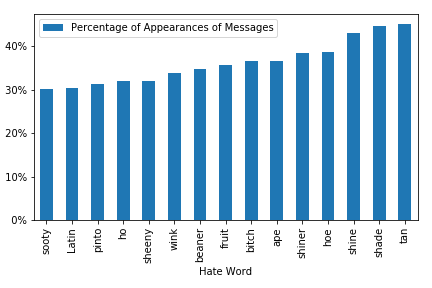Identifying Hate with NTLK, difflib, and Python code!
03 Feb 2018Recently, for our research project, we worked on identifying hate on anonymous platforms.
Here’s an example of a graph of the percentage of the top 15 hate words with dummy data in a random server:

We were inspired by the method of identifying hate outlined in the paper “Kek, Cucks, and God Emperor Trump: A Measurement Study of 4chan’s Politically Incorrect Forum and Its Effects on the Web”.
To code this up, I first had to import a list of hate words. I used the library that the aforementioned paper used: Hatebase. I used a python wrapper to get the top 1000 US hate words:
key = "ENTER_YOU_KEY_HERE"
from json import loads
from hatebase import HatebaseAPI
hatebase = HatebaseAPI({"key": key})
#"language": "eng"
pagenumber = 1
responses = []
#Loads top 1000 results
while pagenumber <= 11:
filters = {"country":"US", "page": str(pagenumber)}
output = "json"
query_type = "vocabulary"
response = hatebase.performRequest(filters, output, query_type)
# convert to Python object
responses.append(loads(response))
pagenumber += 1
print "Done getting API results"
Then, I processed the JSON data received from the API by using Python’s convenient iteritems() function for dictionaries:
#Process Hate Words
data = []
for r in responses:
data.append(r["data"])
#print len(data)
listofHatewords = []
#print len(data)
for z in data:
for a, v in z.iteritems():
for b in v:
listofHatewords.append(b["vocabulary"])
print listofHatewords
listofHatewords = list(OrderedDict.fromkeys(listofHatewords))
print len(listofHatewords)
Then, I used this code from StackOverflow to find different forms of the hate words:
#NTLK
#FROM: https://stackoverflow.com/a/45158719/4698963
from nltk.corpus import wordnet as wn
#We'll store the derivational forms in a set to eliminate duplicates
index2 = 0
for word in listofHatewords:
forms = set()
for happy_lemma in wn.lemmas(word): #for each "happy" lemma in WordNet
forms.add(happy_lemma.name()) #add the lemma itself
for related_lemma in happy_lemma.derivationally_related_forms(): #for each related lemma
forms.add(related_lemma.name()) #add the related lemma
versionsOfWord[index2] = forms
index2 += 1
print len(versionsOfWord)
Then, I initialize 4 lists, size 1000, to gather as much info as possible about hate words and its occurrences in messages such as ID of the message and message content associated with the hate word:
frequency = []
versionsOfWord = []
#frequencyID = []
frequencyTime = []
listmessageID = []
listauthors = []
frequencyIndex = []
for x in range(0, 1000):
frequency.append(0)
"""
for x in range(0, 1000):
frequencyID.append([])
"""
for x in range(0, 1000):
listmessageID.append([])
for x in range(0, 1000):
listauthors.append([])
for x in range(0, 1000):
frequencyTime.append([])
for x in range(0, 1000):
frequencyIndex.append([])
for x in range(0, 1000):
versionsOfWord.append([])
For the main loop, I first search through each message in the messages list (which was imported from prior data). I then make that message lowercase. After, I split it into a words and see if hate words or its forms are in the messages. I also check for censored words (ex: “nger”) via difflib library:
totalNumberofWords = 0
counter = 0
print len(message)
print len(messageID)
print len(timestamps)
for m, m_id, date, a_id in zip(message, messageID, timestamps, authorID):
#print m
totalNumberofWords += len(m)
lower = m.lower()
index = 0
if counter%100000==0:
print counter
#print counter
#Need to tokenize to get all frequencies
for word in listofHatewords:
wordLowered = word.lower()
listof_lower = lower.split(" ")
similarWords = versionsOfWord[index]
#matchesHate = difflib.get_close_matches(word, listof_lower, 1, .5)
#https://docs.python.org/2/library/difflib.html
#Else if check the NTLK forms of words
#Check if there are versions of the word first though
#TOOK out "word in lower" since it was inaccurate
if wordLowered in listof_lower or len(difflib.get_close_matches(wordLowered, listof_lower, 1, .75)) >= 1:
frequency[index]+=1
frequencyIndex[index].append(counter)
#frequencyID[index].append(str(m_id) + " " + m)
frequencyTime[index].append(date)
listmessageID[index].append(m_id)
listauthors[index].append(a_id)
elif len(similarWords) > 0:
#found = False
for a in similarWords:
aLowered = a.lower()
if aLowered in listof_lower or len(difflib.get_close_matches(aLowered, listof_lower, 1, .75)) >= 1:
#found = True
frequency[index]+=1
frequencyIndex[index].append(counter)
#frequencyID[index].append(str(m_id) + " " + m)
frequencyTime[index].append(date)
listmessageID[index].append(m_id)
listauthors[index].append(a_id)
#print "test" + str(counter)
break
#Increase index to make sense
if index >= len(listofHatewords):
print "Length error"
index+=1
counter += 1
Here is how I saved it in a JSON file:
#Process data
jsonList = []
for i in range(0,1000):
jsonList.append({'hateword': listofHatewords[i], 'messageID': listmessageID[i], 'authorID':listauthors[i], 'frequency': frequency[i], 'frequencyIndex':frequencyIndex[i], 'frequencyTime':frequencyTime[i]})
#print(json.dumps(jsonList, indent = 1))
#Put to file
import simplejson
import time
timestr = time.strftime("%Y%m%d-%H%M%S")
try:
f = open(ChannelName + 'Allfrequencies' + str(timestr) +'.json', 'w')
simplejson.dump(jsonList, f)
f.close()
except NameError:
print "Almost erased" + ChannelName + "Allfrequencies.json! Be careful!!!"
Here is how I graphed it in Pandas:
'''
Graphs percentage of mentions of ____ hate word in posts
'''
#print totalNumberofWords
#print frequency
#TODO percentages + save list of hate words into file for further analysis
#Test for every word
#Create matrix where this is the message ||
#parse vector => how many words is mentioned
#counter vectorizer => ski kit learn. vocabulary is list of 1000 words
#^count how many times a word occurs
#Sum of rows
#Find which of the words occur the most
#Use pandas
df = pd.DataFrame({'words':listofHatewords, 'frequency':frequency})
#Sort
df = df.sort_values('frequency')
#print df
#Cut to top ten most popular posts
gb = df.tail(15)
#total number of words
lengthOfMessages = len(message)
#print gb
#Calculate percentage
gb["percentage"] = gb["frequency"]/lengthOfMessages
#print df
del gb["frequency"]
#Rename Columns
gb.columns = ["Hate Word", "Percentage of Appearances of Messages"]
print gb
#Graph percentages
ax = gb.set_index('Hate Word').plot(kind='bar')
plt.tight_layout()
vals = ax.get_yticks()
ax.set_yticklabels(['{:3.0f}%'.format(x*100) for x in vals])
im = ax
image = im.get_figure()
image.savefig(ChannelName + 'HateSpeechBar.png')
And that’s it! This code does not detect the context of conversation such as sarcasm and solely tests for existence of words in messages.